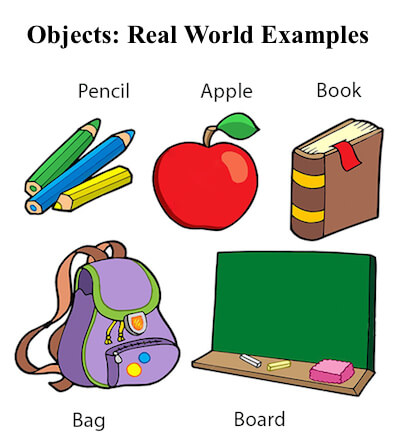Object in Java

An entity that has state and behavior is known as an object e.g.
chair, bike, marker, pen, table, car etc. It can be physical or logical
(tengible and intengible). The example of integible object is banking
system.
An object has three characteristics:
- state: represents data (value) of an object.
- behavior: represents the behavior (functionality) of an object such as deposit, withdraw etc.
- identity: Object identity is typically implemented
via a unique ID. The value of the ID is not visible to the external
user. But,it is used internally by the JVM to identify each object
uniquely.
| For Example: Pen is an object. Its name is Reynolds,
color is white etc. known as its state. It is used to write, so writing
is its behavior.
|
Object is an instance of a class. Class is a template or blueprint from which objects are created. So object is the instance(result) of a class. Object is the physical as well as logical entity whereas class is the logical entity only.
Example of Object and class that maintains the records of students
| In this example, we are creating the two objects of
Student class and initializing the value to these objects by invoking
the insertRecord method on it.
Here, we are displaying the state (data) of the objects by invoking the
displayInformation method.
|
- class Student2{
- int rollno;
- String name;
-
- void insertRecord(int r, String n){
- rollno=r;
- name=n;
- }
-
- void displayInformation(){System.out.println(rollno+" "+name);}
-
- public static void main(String args[]){
- Student2 s1=new Student2();
- Student2 s2=new Student2();
-
- s1.insertRecord(111,"Karan");
- s2.insertRecord(222,"Aryan");
-
- s1.displayInformation();
- s2.displayInformation();
-
- }
- }
Test it Now
What are the different ways to create an object in Java?
There are many ways to create an object in java. They are:
- By new keyword
- By newInstance() method
- By clone() method
- By factory method etc.
We will learn, these ways to create the object later.
Annonymous object
| Annonymous simply means nameless.An object that have no reference is known as annonymous object.
|
| If you have to use an object only once, annonymous object is a good approach. |
- class Calculation{
-
- void fact(int n){
- int fact=1;
- for(int i=1;i<=n;i++){
- fact=fact*i;
- }
- System.out.println("factorial is "+fact);
- }
-
- public static void main(String args[]){
- new Calculation().fact(5);
- }
- }
Creating multiple objects by one type only
| We can create multiple objects by one type only as we do in case of primitives. |
- Rectangle r1=new Rectangle(),r2=new Rectangle();
- class Rectangle{
- int length;
- int width;
-
- void insert(int l,int w){
- length=l;
- width=w;
- }
-
- void calculateArea(){System.out.println(length*width);}
-
- public static void main(String args[]){
- Rectangle r1=new Rectangle(),r2=new Rectangle();
-
- r1.insert(11,5);
- r2.insert(3,15);
-
- r1.calculateArea();
- r2.calculateArea();
- }
- }
 An entity that has state and behavior is known as an object e.g.
chair, bike, marker, pen, table, car etc. It can be physical or logical
(tengible and intengible). The example of integible object is banking
system.
An entity that has state and behavior is known as an object e.g.
chair, bike, marker, pen, table, car etc. It can be physical or logical
(tengible and intengible). The example of integible object is banking
system.
No comments:
Post a Comment